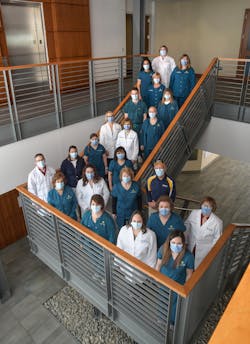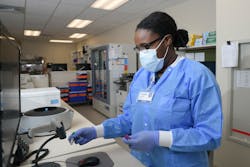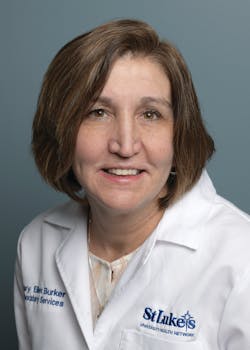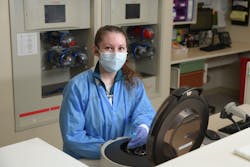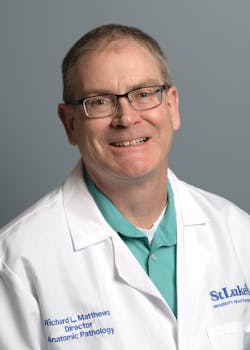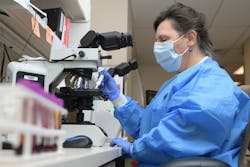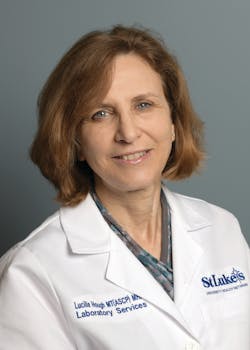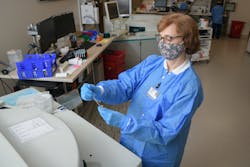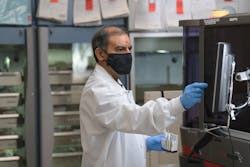St. Luke’s University Health Network Laboratory Services – dedicated to patients
Judging the entries for Medical Laboratory Observer’s Lab of the Year award is always a daunting job. This was particularly true this year, given the central role clinical labs have played in managing the COVID-19 pandemic.
As MLO’s staff and judges reviewed every entry, we read many inspiring stories about how laboratorians worked diligently and courageously to ramp up COVID-19 testing while continuing to provide other diagnostic services.
But in the end, a winner emerged. MLO’s 2021 Lab of the Year is St. Luke’s University Health Network Laboratory Services.
Located in Bethlehem, PA, the 12-hospital system treats patients in 11 counties in Eastern Pennsylvania, including Allentown and Easton, and across the border in Warren County, NJ. With more than 16,000 employees, 270 outpatient locations and three nursing homes, the network is expanding, with plans to open an 80-bed hospital in Carbon County, PA, in 2021.
At St. Luke’s, Network Laboratory Services is an integral part of the health system’s continued growth. Its 469 employees perform more than 5 million tests per year through 10 rapid response labs (which serve inpatient units and emergency departments), one core lab and one specialty lab. Patient specimens are collected at 50 patient service centers and a mobile phlebotomy program. In addition, 14 pathologists – with specialties including dermatopathology and neuropathology – analyze more than 60,000 specimens annually.
Customer service
That effort starts with customer service.
One example is a profitable mobile phlebotomy program, which the lab network staffs with 4.5 full-time equivalent (FTE) employees who draw blood samples in the comfort of patients’ homes. Although it was launched in 2017, the program took off in May 2020, after lab directors removed a $25 service fee, allowing the number of patient accounts to grow by 2,600. The average number of visits increased from 3.2 visits per day to 18 visits per day. The payment per visit varied, depending on whether the account was self pay, commercial insurance or government program.
After the outbreak of COVID-19, the lab assigned one phlebotomist to draw blood samples from patients who were COVID-19 positive or awaiting SARS-CoV-2 test results. This provided ease of access for patients dealing with COVID-19, as the lab did not want to “make someone who is sick travel,” Burrell explained in an interview, pointing out that these patients might need tests to monitor chronic conditions or manage COVID-19 symptoms.
Another initiative – a central call center – is targeted at both patients and providers.
The network call center is staffed with 10 FTEs, which includes a supervisor, customer service representatives and technical support specialists. In 2020, the call center handled 55,427 incoming calls and placed 19,461 calls to patients and providers. The average time on hold was 19 seconds. More than 90 percent of the calls were answered without a delay (within 4 rings).
In addition to assisting customers, the call center also helps to monitor a lab-outreach quality-assurance program, and it is responsible for notifying the state and local health departments of test results related to mandatory reporting.
The key to the program’s success is lab managers’ commitment to training staff on how to answer callers’ questions accurately and succinctly. “The clinical staff caring for the patient doesn’t always have time for long, drawn out responses,” Burrell explained in the nomination submission.
In response to the pandemic, customer service in 2020 also included outreach to local colleges and nursing homes – both of which needed help with SARS-CoV-2 testing.
St. Luke’s provided test collection kits to nine nursing homes (in addition to the three facilities that St. Luke’s owns) and processed their tests, including those for surveillance, with an average turnaround time (TAT) of 24 hours.
St. Luke’s also provided analyzers and reagents to five local colleges. Two of St. Luke’s employees taught the on-campus clinic staff members how to perform multiplex testing for COVID-19, flu A/B and RSV. The health system’s employees also provided ongoing management and oversight of the testing programs.
Productivity
As is the case in labs throughout the country, St. Luke’s strives to improve productivity.
One project – the practice of alerting providers about critical values on lab tests – improved both customer service and productivity. “As you know, this can be an extremely time-consuming process for staff, but also extremely frustrating and dangerous when the ordering provider cannot be contacted,” Burrell wrote in the nomination letter.
Anatomical pathology (AP) also improved productivity in 2020. St. Luke’s goal is for the AP staff and pathologists to prepare, read, and finalize 90 percent of specimens within 72 hours. By that definition, TAT was 14 percent in December 2019.
To improve productivity, the managers with input from pathologists used fishbone diagrams to analyze the histology process. They realized that the task of embedding samples, or hardening them in a fixative, was a bottleneck in the process. This happened, because staff was handling embedding in addition to other duties. “No one was actually assigned to the embedding stations for an entire shift,” Burrell explained.
Other pieces of histology operations – accessioning, grossing and microtomy – showed similar issues.
To solve the problem, St. Luke’s added additional staff to each area, growing the FTE count from 43 in January 2020 to 56.75 in December 2020.
As a result of these efforts, St. Luke’s was able to meet TAT expectations 94.3 percent of the time by October 2020. The TAT improvement occurred despite increases in surgical volume, which rose from 5,236 cases in January 2020 to 5,802 cases in October 2020.
The blood bank also logged productivity improvements. It implemented a test to detect bacterial contamination in platelets, extending expiration dates on units of platelets. With the implementation of Verax testing in 2018, the number of wasted platelet units dropped by 35 percent to under 5 percent, averaging 2.5 percent in FY19 and 2.9 percent in FY20. The lab also saved $110,000 by wasting fewer platelet units between 2018 and 2020.
Teamwork
Teamwork at St. Luke’s was tested in 2020, as the lab staff worked to manage the workload, despite job-sharing arrangements and the ever-present national shortage of medical technologists.
“We have had to rely on out-of-the-box thinking to staff our departments, and the team has pulled together to, not only cover their own departments, but help cover other campuses,” Burrell said. There are many anecdotal examples, such as:
- A microbiology technical coordinator with previous experience in histology who put in extra time to prepare quality control slides.
- A histology supervisor who spent weeks embedding specimens, so her team could focus on microtomy.
- Lab managers who supervised multiple rapid-response labs, because St. Luke’s was not able to hire enough qualified managers.
- POCT coordinators who filled in as medical technologists working at lab-testing stations.
Education and training
St. Luke’s is combatting national shortages in lab personnel by developing education programs internally.
For example, the lab outreach team is designing a new phlebotomy training program. “During this past year, we have found it more and more difficult to recruit good phlebotomists. We decided that training our own is a better solution than using a staffing agency,” Burrell said in the nomination submission.
The idea was modeled after a similar approach in histology; although, St. Luke’s works with an accredited college in that case. “We help lab aides or other hospital employees gain valuable knowledge and expertise in histology,” Burrell said, noting that the lab network has hired six employees from this program over the last three years.
In 2020, the lab network launched two paid-internship programs: one for microbiology and a second for medical laboratory science. For microbiology, the internship is generally offered to a lab aide with a college degree who expresses interest in the field. Meanwhile, anyone with a college degree in one of the life sciences and who meets CLIA requirements, can apply for an internship in medical laboratory science.
Laboratory Inspections
Over the last several years, St. Luke’s has developed a quality team comprised of project managers and medical technologists who perform scheduled mock inspections and audit compliance with policies and procedures. The lab also has standardized document control. Based on the results of this work, the lab develops performance improvement initiatives to address identified deficiencies. In addition, each inspection outcome is debriefed during manager-level meetings, so recommendations for improvement can be implemented throughout all labs in the network.
“This has been challenging since restrictions still exist. Depending on the inspection team, we will be having a combination of virtual and on-site inspections,” Lucille Hough, MT (ASCP), MHA, Network Director of Clinical Pathology, said.
Strategic Outlook
The lab network also develops strategic plans, allowing it to continue improving the work it does.
In addition, the network lab plans to standardize equipment in its rapid response labs. This includes new chemistry equipment and additional analyzers for procalcitonin. In the specialty lab, St. Luke’s also plans to bring in house flow cytometry and direct immunofluorescence – services that are now sent to reference labs.
“Our network is all about patient access. Anything we can do to get patients to invest in their health we will do,” Burrell said. “Life is so busy, so it so important to offer convenience.”
